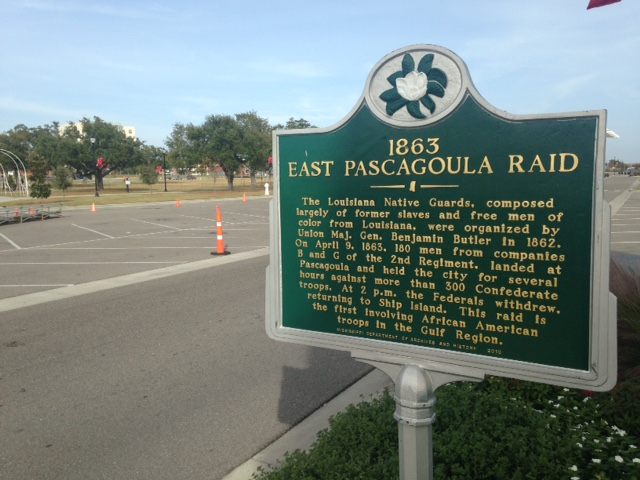East Pascagoula Raid
On April 9, 1863, the residents of East Pascagoula, Mississippi, had a day like no other. Union warships lurked offshore in the Gulf of Mexico. Their presence was nothing abnormal for Southern residents along the coast. The Union military had captured New Orleans in April 1862, which was only 80 miles to the west. Furthermore, the Union navy had instituted a blockade in an attempt to strangle the economic and military trade of the rebelling states.
One hundred and thirty miles to east sat one of only three forts to remain in control of the United States from before the Civil War (and would ultimately remain in U.S. control through the duration): Fort Pickens, Florida.
However, this spring day, Union blue-coated soldiers would splash ashore, conduct a raid of the town, and even hoist a Union flag on top of the courthouse. What made the enemy presence even more detestable for these Southern civilians was that the Union infantry force was comprised of African-American soldiers of the Louisiana Native Guards.

The Louisiana Native Guards contained former slaves and free African-Americans and became one of the first all-African-American regiments in the service of the United States Army. The command would play a conspicuous part in the reduction and eventual capture of the last Confederate bastion on the Mississippi River at Port Hudson, which would fall to the Union exactly two months after The Louisiana Native Guards splashed ashore in East Pascagoula.
The raid on East Pascagoula lasted only two hours and consisted of only two companies from the Louisiana Native Guards, Companies B and G. However, the African-Americans showed their prowess by holding the city for a couple hours against Confederate forces. During the ensuing melee, the Guards successfully defended their positions around the town against the concerted efforts of the Confederates, and they even captured a stand of Confederate colors for their effort.
With Confederates pressing in and trying to reload the vessels to take them back to the Union transport ships, the Guards showed their composure under fire. Unfortunately, some of that fire was of the “friendly” type, fired by the Union gunboats offshore. During the evacuation, when one of the Union supporting gunship’s artillery rounds landed short of its intended target and killed four soldiers, the Guards did not panic and loaded up and sailed off.
This raid and engagement was the first conducted by African-American soldiers in the Gulf of Mexico region. Today, a historical marker near the wharf in Gulfport (the current name for East Pascagoula) tells the history of that April day. A National Park Service concessionaire does take boat trips, in season, out to some of the Gulf Islands. Fort Massachusetts was garrisoned by the 1st Louisiana Native Guards (all told there would be three regiments of Louisiana Native Guards before the war ended) for three years during the war. The fort is preserved and protected by the National Park Service and can be visited via the boat tours of the concessionaire.

This is a relatively minor incident in the war, but showed the capacity of African American soldiers to fight. Unfortunately, white supremacy and privilege has been slow to die.
Not sure what that comment has to do with the subject at hand ?
Probably referring to the many variations of the real facts. Depends on who wrote the follow up articles. Some articles about this small skirmish are pro Confederate and some are Anti the African soldiers.
Thank you for a well research article Phil
However Gulfport (see last paragraph in the article) is NOT the current name of East Pascagoula – East Pascagoula is now Pascagoula.
Holding city against who, old men and boys with sticks and shovels? Native Guard was slaughtered at Port Hudson Wo ever firing a shot. Take about a post modernist take. The PC of the article makes me want to puke.